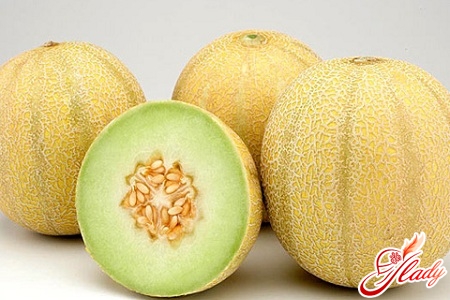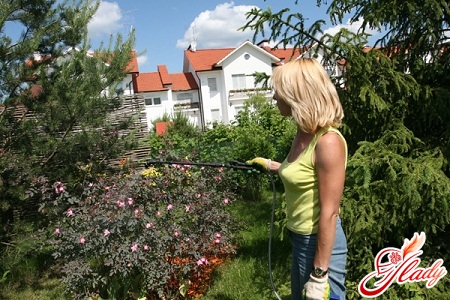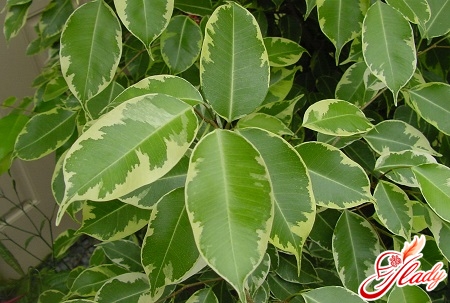 Ficus can be classified as unpretentiousindoor plants. It grows well in apartment conditions, and the basic requirements for caring for it do not differ dramatically from the requirements for the maintenance of other types of plants. But, despite its unpretentiousness to the surrounding conditions, ficus, like other indoor flowers, is susceptible to various diseases. And basically, ficus diseases are associated with such obvious reasons as lack of prevention, infection from other neighboring plants and failure to comply with the conditions of maintenance.
Ficus can be classified as unpretentiousindoor plants. It grows well in apartment conditions, and the basic requirements for caring for it do not differ dramatically from the requirements for the maintenance of other types of plants. But, despite its unpretentiousness to the surrounding conditions, ficus, like other indoor flowers, is susceptible to various diseases. And basically, ficus diseases are associated with such obvious reasons as lack of prevention, infection from other neighboring plants and failure to comply with the conditions of maintenance.
How to prevent ficus disease
With sufficiently competent care, ficuses willfeel comfortable and will delight you with their good health. But, unfortunately, you can catch an infection or become infected with pests from other plants, when transplanting into new soil or when outdoors. Therefore, first of all, it is always necessary to observe preventive measures:
- For the "recruit", the content in theweek quarantine. Ideal option - isolated from other plants room. If after the quarantine you do not find any signs of disease, the ficus can be placed among the other colors.
- Daily inspection of the ficus for signs of diseases and pests.
- Monthly rubbing of leaves with a soap solution. This procedure must be carried out after a long stay of the ficus on the balcony or in the garden.
- Regular cleaning of pallets and pots; disinfection of the soil with the help of a weak solution of potassium permanganate.
- Observance of the necessary distance between plants: you can not put pots of flowers very close to each other. In excessive crowding, infectious diseases and pests are easily transmitted.
The main task of flower growers for a favorabledevelopment of ficus is the creation of optimal conditions. Illiterate maintenance of flowers contributes to frequent damage by pests, fungal and viral infections. Causes of diseases Ficus diseases can also be associated with unfavorable conditions of its maintenance:
- Incorrect lighting and temperature in the room where the ficus is contained;
- Insufficient air humidity;
- Unsatisfactory plant watering: lack or excess of moisture;
- Weak mineralization or overfeeding of fertilizers;
- Unbalanced soil composition.
It should be noted that the most common arecomplaints related to wilting, yellowing or falling leaves, and it is wiser to first change the existing conditions: increase or, conversely, decrease the amount of watering, change the location of the ficus from the shade to the sunny side or, conversely, remove it further from the sun's rays, transplant the plant into new soil, and so on.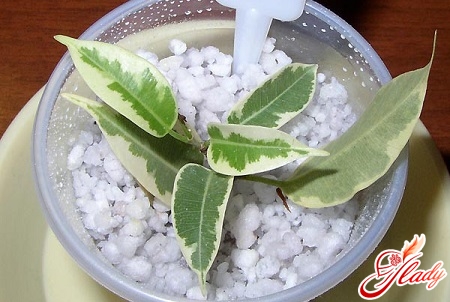
Diseases of leaves
Let's find out what leaf diseases this plant can have.
- Leaves turn yellow.
A common cause of yellowing of the ficus leaf isdry indoor air. This happens especially often in winter for plants located near heating radiators. Hot air dries out the leaves, they gradually turn yellow, wither and fall off. If a large number of leaves are lost, the ficus may die. What to do? The best way to solve the problem is to move the flower to another, more suitable place for it, and install a humidifier. If this is not possible, cover the radiator with a thick blanket and spray the plant more often. Another reason for the yellowing of the leaf can be stress associated with frequent movement of the ficus from place to place. Try to immediately determine a favorable location for your flower, taking into account your convenience, so as not to bother it with all sorts of rearrangements in the future.
- Grinding or falling of leaves
A sign such as the crushing of new leaves,yellowing and falling of old ones indicates a lack of nutrients. What to do? Transplant into new balanced soil. When transplanting a flower into a new pot, it is necessary to prepare the correct substrate. It must necessarily contain equal parts of peat, sand and leaf soil. After transplanting the ficus, the soil must be moderately watered. The appearance of yellow spots and yellowing of the edges of the leaves, their lifeless appearance and falling off, will most likely be associated with an excess of moisture in the soil. The main rule for watering a ficus is to let the soil dry out before the next watering. Excess moisture will lead to rotting of the root system and further death of the plant. If the soil was flooded, it is necessary to wait until the soil dries out completely. And in case of a sharp fall of leaves, transplant the flower into dry soil, removing the rotting roots. Unfortunately, even scanty watering of the plant can have negative consequences - dry and wrinkled leaves. In this case, not only the leaves, but also the roots of the ficus dry out, which, accordingly, can also cause the death of the flower. The appearance of brown spots on the tips and edges of the leaves is associated with high room temperatures, lack of humidity, or frequent fertilizing.
- Falling leaves at the bottom of the trunk
In most cases, ficus trees have tree-like formsThe lower leaves fall off naturally, due to aging. However, the trunk should not be exposed. This sign indicates the need to replant the ficus, or perhaps that the replanting was done in an unbalanced substrate, or additional soil fertilization is required.
- Leaf decay
A serious illness that is associated with moreserious problems: infections and pest damage. In such a situation, you cannot do without insecticides. For correct diagnosis of the disease, it is necessary to conduct a thorough examination of the leaves and stem.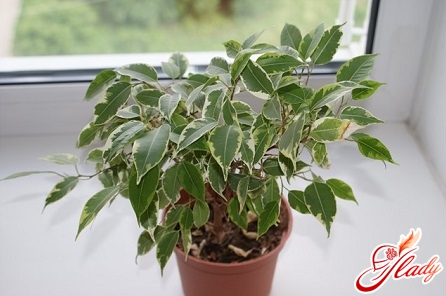
Pests of ficus
Scale insect Sign: появление коричневых выпуклых пятнышек, в основном на внутренней стороне листа вдоль жилок, но не исключено и появление на стволе и поверхности листьев. Щитовки высасывают сок из растения, оставляя после себя липкий налет, который, в свою очередь, приводит к появлению сажистого грибка. Меры борьбы: в первую очередь необходимо ручным способом очистить листья мыльным раствором. Затем трехкратно в течение двух-трех недель обработать растение составом актеллика. Мучнистый червец Внешний напоминает кусочки ваты, внутри которых поселяется вредитель коричневого цвета, высасывающий сок из листьев, задерживая при этом рост растения. Легко и быстро переносится с цветка на цветок ветром и сквозняком. Чаще всего поселяется в пазухах листьев. Меры борьбы: механическая очистка листьев от червецов и «ваты», трехкратное опрыскивание мыльной водой или табачным раствором через каждую неделю. В тяжелых случаях обработка растения конфидором в два приема с интервалом в десять дней. Паутинный клещ: желтый и красный Благоприятное условие для появления паутинного клеща — сухой и теплый воздух. Клещик повреждает поверхность растения, вгрызаясь в нежные листья и высасывая при этом сок. Оставляет после себя серо-бурые пятна. Размножается этот вредитель очень быстро. Большие колонии образуют паутину на цветке, листья вянут и опадают. Меры борьбы: увеличение влажности воздуха, частое опрыскивание листьев, периодический душ для цветка и обработка мыльным раствором. Для лечения растения можно также накрыть растение полиэтиленом на три-четыре дня, а затем опрыскать молотой серой или настоем чеснока. При необходимости быстрого лечения следует использовать любой инсектицидный препарат. Трипс Поселяется небольшими группами вдоль жилок на внутренней стороне листьев. Оставляет после себя темно-коричневые пятна. Активному размножению трипсов способствуют высокая температура и повышенная влажность. У листьев появляется неравномерная желто-белая окраска, затем они высыхают и опадают. Кроме того, это насекомое-вредитель распространяет вирусы. Меры борьбы: неоднократное опрыскивание фикуса раствором пиретрума или препаратами Актара, Актиллик, Танрек и др. Повторность процедуры крайне важна, так как инсектициды действуют только на определенной стадии развития трипса. Тля Тля опасна не только своей назойливостью и активностью в весенне-летний период, но и весьма быстрым заражением других растений за счет своей способности летать. В основном собирается кучками на нижней стороне листьев. Пораженные листья желтеют и скручиваются. Меры борьбы: промыть листья мыльным раствором или разведенным пиретрумом. Нематоды Явным признаком поражения нематодами является появление на корнях бусинок, узелковых наростов с горошинку. Токсичные выделения этих микроскопических нитчатых червей через корневую систему проникают в ствол и листья, обесцвечивая их, и фикус постепенно чахнет. Опасно заболевание тем, что на начальном этапе заражения невозможно заметить каких-либо изменений в развитии фикуса. Такое растение уже нельзя использовать для вегетативного размножения. Если только срезать идеально здоровый лист и вырастить новый фикус. К счастью, почти всех вредителей можно так или иначе уничтожить с помощью инсектицидных препаратов. Намного сложнее излечить растение от серьезных инфекционных и грибковых болезней. В большинстве случаев обнаружить признаки заболеваний на ранней стадии не всегда удается, а в запущенных случаях лечение оказывается уже бесполезным. Но все же всегда есть шанс спасти свой любимый цветок. 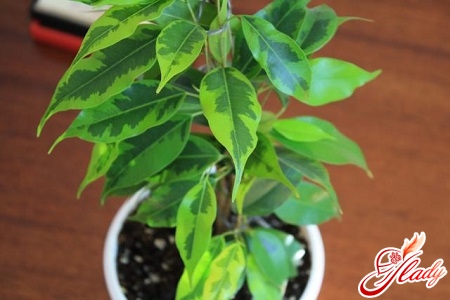
Fungal diseases
Gray rot Outwardly manifests itself as graymold covering the leaves and stem of the ficus. If you shake the leaf a little, it easily flies off, forming a cloud of floating dust. Affected leaves darken and die. The consequence of the appearance of this fungus is damp and warm air. Control measures: decisively remove all affected parts of the ficus. Ventilate the room more often, reduce the frequency and volume of watering. Be sure to let the soil dry out during the day. Sooty fungus A favorable environment for the formation of sooty fungus is sticky secretions of pests: scale insects, aphids, etc. It looks like a gray-black coating on the leaves. Powdery mildew, on the contrary, has a characteristic white color and is easily erased. Control measures: treat the plant with a sponge soaked in soapy water. If the affected area is large, then it is necessary to remove all infected leaves and spray the leaves and roots with a funcicide solution. Fungi on the leaves Cercospora - small black spots. In severe cases, the leaves turn yellow and die. Anthracnose - rusty spots, burnt areas along the edges of the leaves, turning into an ulcerated state. The consequences are identical - the leaf dies. Botrytis - yellow-brown spots that increase in size. Characterized by a visible black-brown areole. Control methods: remove all affected parts of the plant and treat with a fungicide. Root rot The consequence of the appearance of this fungus is constant over-moistening of the soil. The ficus gradually withers, acquiring a grayish appearance. Foci of decay appear on the stem and roots. Control measures: do not exist, the plant must be thrown away along with the pot. This infection can lie dormant in the soil for a long time. Fungi and bacteria are not the only causes of diseases of indoor ficuses. For example, overwatering can cause such a popular nuisance as dropsy. Externally, it manifests itself in the form of plugs on the inside of the leaf. It is no longer possible to cure such a leaf. Control measures: none, remove all affected leaves. The causes of ficus diseases are as primitive as their variety. Following basic care rules, regular prevention and love for indoor plants are the main conditions for successful and favorable maintenance of your ficus.




